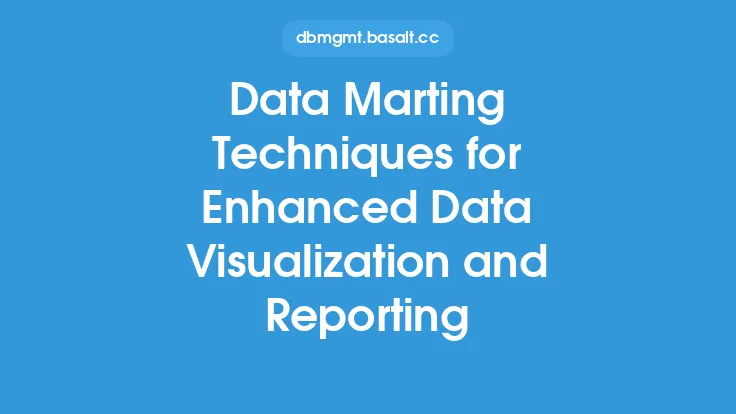Data organization and storage are crucial aspects of database management, as they directly impact the performance, scalability, and maintainability of a database. One technique that has gained significant attention in recent years is denormalization, which involves intentionally deviating from the principles of normalization to improve data retrieval and storage. In this article, we will delve into the world of denormalization techniques, exploring their benefits, trade-offs, and applications in data organization and storage.
Introduction to Denormalization
Denormalization is a database design technique that involves storing data in a way that reduces the number of joins required to retrieve data, thereby improving query performance. This is achieved by storing redundant data or aggregating data in a single table, rather than following the traditional rules of normalization. Denormalization is often used in databases that require high performance, such as those used in e-commerce, social media, and big data analytics.
Types of Denormalization
There are several types of denormalization techniques, each with its own strengths and weaknesses. Some of the most common types of denormalization include:
- Pre-aggregation: This involves storing pre-calculated aggregate values, such as sums or averages, in a separate table. This can improve query performance by reducing the need for complex calculations.
- Pre-joining: This involves storing data from multiple tables in a single table, reducing the need for joins. This can improve query performance by reducing the number of tables that need to be accessed.
- Data duplication: This involves storing duplicate data in multiple tables, reducing the need for joins and improving query performance.
- Summary tables: This involves storing summary data, such as aggregate values or statistics, in a separate table. This can improve query performance by reducing the need for complex calculations.
Benefits of Denormalization
Denormalization offers several benefits, including:
- Improved query performance: By reducing the number of joins required to retrieve data, denormalization can significantly improve query performance.
- Reduced storage requirements: By storing data in a more compact form, denormalization can reduce storage requirements and improve data density.
- Simplified data retrieval: Denormalization can simplify data retrieval by reducing the number of tables that need to be accessed.
- Improved data scalability: Denormalization can improve data scalability by reducing the number of joins required to retrieve data, making it easier to handle large amounts of data.
Trade-Offs of Denormalization
While denormalization offers several benefits, it also has some trade-offs, including:
- Data inconsistency: Denormalization can lead to data inconsistency, as changes to the data may not be reflected in all tables.
- Data redundancy: Denormalization can lead to data redundancy, as data is stored in multiple tables.
- Increased storage requirements: While denormalization can reduce storage requirements in some cases, it can also increase storage requirements in other cases, particularly if data is duplicated.
- Complexity: Denormalization can add complexity to the database design, making it more difficult to maintain and update.
Applications of Denormalization
Denormalization has a wide range of applications, including:
- Data warehousing: Denormalization is often used in data warehousing to improve query performance and reduce storage requirements.
- Big data analytics: Denormalization is often used in big data analytics to improve query performance and reduce storage requirements.
- E-commerce: Denormalization is often used in e-commerce to improve query performance and reduce storage requirements.
- Social media: Denormalization is often used in social media to improve query performance and reduce storage requirements.
Best Practices for Denormalization
To get the most out of denormalization, it's essential to follow best practices, including:
- Carefully evaluate the trade-offs: Before implementing denormalization, carefully evaluate the trade-offs and ensure that the benefits outweigh the costs.
- Use denormalization judiciously: Denormalization should be used judiciously, as over-denormalization can lead to data inconsistency and complexity.
- Monitor data consistency: Regularly monitor data consistency to ensure that changes to the data are reflected in all tables.
- Use data validation: Use data validation to ensure that data is accurate and consistent.
Tools and Technologies for Denormalization
There are several tools and technologies that can be used to implement denormalization, including:
- Database management systems: Most database management systems, such as MySQL and Oracle, support denormalization.
- Data warehousing tools: Data warehousing tools, such as Amazon Redshift and Google BigQuery, support denormalization.
- Big data analytics tools: Big data analytics tools, such as Hadoop and Spark, support denormalization.
- NoSQL databases: NoSQL databases, such as MongoDB and Cassandra, support denormalization.
Conclusion
Denormalization is a powerful technique that can be used to improve data organization and storage. By understanding the benefits, trade-offs, and applications of denormalization, database designers and administrators can make informed decisions about when to use denormalization and how to implement it effectively. By following best practices and using the right tools and technologies, denormalization can be a valuable addition to any database design. Whether you're working with a small database or a large-scale data warehouse, denormalization is definitely worth considering.





